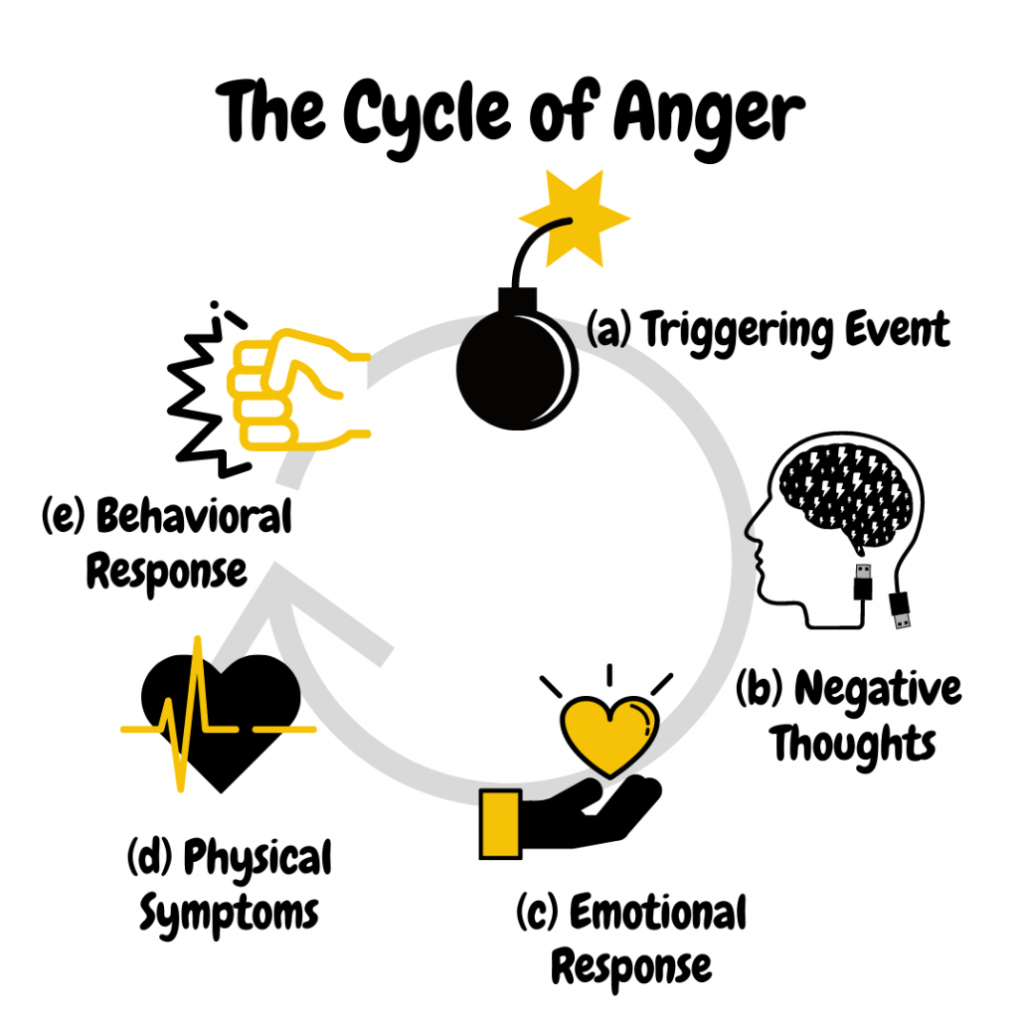A Quick Guide
Anger is a natural response to frustration and can manifest physically with symptoms like high blood pressure and increased heart rate. Adaptive anger can motivate us to overcome challenges, but maladaptive anger leads to self-defeating or aggressive behaviors. The anger cycle involves triggers, thoughts, emotions, physiological reactions, and behaviors. Managing anger involves recognizing triggers, identifying and transforming irrational thoughts, and cultivating healthier perspectives. By working on ourselves and our reactions, we can reduce the intensity of anger and foster a more constructive approach.
What is Anger?
We all experience this emotion in our daily lives. Since is a natural reaction to frustration. We respond with anger when we feel threatened, insulted, or provoked. So any situations or people that trigger these feelings in us may receive our hostile reaction.
Physical signs
Physically, it may manifest in us in the form of:
- High blood pressure
- Pounding headache
- Increased heartbeat
- Red face
- Sweating
- The rush of energy in hands and feet
- Clenching Jaw or teeth
- Shaking/Trembling
Adaptive vs maladaptive anger
Being angry is not all bad since it motivates us as well if we approach it in an adaptive manner. For example, someone comments ‘You are a loser. You can never do well at your job’. Naturally, this angers you but you use this feeling to prove the person wrong by working hard and performing well at your job. This is an example of adaptive anger in action.
Unfortunately, not all feelings and responses to anger are adaptive. Since it becomes maladaptive when we get too aroused with aggression. Some people direct it inwards such that it becomes self-defeating. Whereas, others direct it outwards at others. They may manifest it in the form of behaviors like breaking objects, shouting, cursing, getting into arguments, hitting people, etc.
The anger cycle
From the perspective of Cognitive Behavioral Therapy, our thoughts, emotions, physiological reactions, behaviors, and situations/triggers are interconnected. Any of these five factors can trigger the cycle of anger in us. The triggers or the event may vary for each person. This explains why different people respond to the same situation or event differently. Similarly, the behavior or how anger is manifested may also vary. For example, when angry some people cry, others go quiet, and some start shouting, or use violence.

The role of our thoughts
The way we talk to ourselves matters a lot in determining and regulating our feelings and behaviors. Usually, people’s thinking in anger consists of ‘shoulds’ or ‘musts’. For example, ‘My boss should treat me with respect’. Or ‘My parents must not control me’ etc. So even though in some cases our expectations to have our needs and wishes to be fulfilled are valid, reality doesn’t work that way. And if we start expecting others to change instead of ourselves, we are setting ourselves up for a life of aggression and hostility. So it is better we work on ourselves and our reactions since that’s where we have higher control.
To learn this, let’s first look at the thoughts of anger. All of us have automatic thoughts in our minds whose content varies across situations. Suppose a situation triggers anger in you, your thoughts will have an angry tone and irrational content. You must learn how to transform it into a more neutral tone and with rational content. Once you do that, your feelings of anger will gradually reduce in intensity.
Watch: [Anger Management]
Managing thoughts in anger
Write the following five factors down in a journal. Initially, you will have to do this after an anger episode. Later on, with practice, you will be able to do the following at that moment.
Identify your thoughts
- Start by identifying your triggers. Notice which situations or people make you angry.
- What thoughts do you have at the time? Write these down.
- How do you feel? Is it just anger or some other emotion as well e.g. sadness? Disappointment?
- Rate the intensity of your emotions from 1-10.
- What did you feel in your body?
- How did you respond or behave?
Transform your thoughts
Once you have written down your thoughts, acknowledge them but target and try to transform them into healthier thoughts.
For example,
Trigger: Your mother didn’t give you permission to go to a party.
Thoughts: ‘She is trying to control my life’ ‘She doesn’t want to see me happy’ ‘Who the hell is she to tell me what to do’.
Healthier thoughts: ‘Yes I do feel bad because I cannot go to the party but maybe she’s concerned it’s not safe’.
Try practicing transforming your thoughts into healthier alternatives. Once you do that, record the intensity of your emotions again. Hopefully, it will reduce.
To learn additional strategies, check out the next article ‘Anger management: 7 Effective Strategies to Control Your Anger‘ and Road Rage: How to manage it using 9 simple tips.



 Understanding Anger: 8 Effective Anger Management Strategies
Understanding Anger: 8 Effective Anger Management Strategies